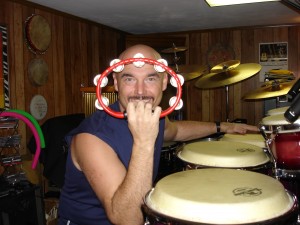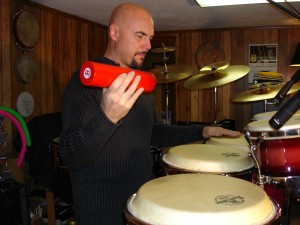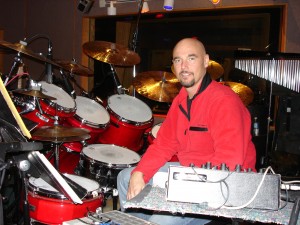When learning new material I just sit and listen. I don’t try to play right away. Let the song get in your head!! Mark the tempo while the writer or leader is playing the song down, make notes on the chart or make a chart if needed; try to hear (or visualize) what will happen in each section. You could tap along or play air drums, but don’t be distracting during the birthing of an arrangement. When it’s time for the band to play together then play what felt like the obvious drum feel you heard in your head. Then let the song evolve from there… ask questions… Make sure the artist and/ or producer is happy. We’re always serving!!
Can’t Get Away From The Click

Carl & Leann w/ Italy team
I was sharing at another team training weekend about learning songs properly and ALWAYS using the click. I often do the band leader thing while playing guitar and singing with Leann. This is a short clip from a recent event where I’m encouraging the drummer and bass player… The fundamentals are still crucial to doing a job well in any field.
Watch the clip!
Overdubbing Adds “Spice”!

“I see you” , Tambourine Man
After getting basic tracks recorded it’s usually expected that every player will add extra parts to the song. Besides recording extra guitars, keyboards, and vocals… I almost always add shakers, tambourines, loops, special effects, whatever we feel the song needs.
Here’s a fun clip from a Paul Baloche project… Ben Gowell and I are adding large drum fills to a tune. We got to laughing as we played… just watching each other and Paul running around with a flip video. 🙂 … I can’t even remember the song we were working on.
Honored To Make The TOP 20 List

Hey you!!
Wow, I was so blessed that the guys at worshipdrummer.ca put my Worship Grooves DVD on there Christmas list. http://www.worshipdrummer.ca/gift-ideas-2011/ There’s still time for domestic orders to make it before Christmas. Get your shopping done now. Such great deals on all my DVDs. You can afford one more present for your drummer OR yourself. 🙂 $10 each for everything in my store!! Happy Holidays & Merry Christmas everyone.
The Art of Percussion

Carl overdubbing a shaker & conga part
The Drummer & Percussionist:
*Two heads are better than one?*
**Or the two headed monster!**
I’ve been very fortunate to work with some amazing musicians. Drummers, percussionists, and other players have made the job of creating music a shear delight. On the other hand, there have been moments of extreme frustration when a musician was not grooving or connecting with the band. It could be a technical problem. Like a player not keeping good time, playing too loudly, or not playing the proper part or style. Sometimes it’s an emotional thing. Like someone thinking too highly of themselves (arrogance) or just not caring about what they are doing (boredom). Either way it makes for a bad day for the band.
For a drummer and percussionist to work together well, every aspect has to be in place. Both players must really be “locked in” to the tempo. Dynamically, they need to sound like one unit. Their parts must be carefully arranged to work well with each other, and to compliment the rest of the group. And it helps if they have at least a good working relationship, if not a real friendship.
As a drummer, I look for the percussionist to “weave” their playing into mine. The drummer is still “driving the bus” so to speak. The percussionist should never try to push or pull the tempo around. They should always try to line up their time & feel to what the drummer is doing. I want their part to compliment what I am playing and in general make the music sound great! When I’m playing percussion, I always remind myself that the drummer is the Christmas tree and I’m the ornaments. In this case, we need to see more green than silver, if you catch my drift. 😉
I’ve heard percussionist say that their drummer doesn’t play well and that they HAVE to over power them to make the music work. That could be true, but my first recommendation is to work it out first. Get with your drummer and start practicing with a metronome, or drum loops. Communicate with each other. Build a relationship where you think as a team, and learn to help each other. Music never seems to feel really good when there is a musical or personal battle on stage. *More on this later.
I can always tell when the percussionist is NOT listening to what the drummer or the rest of the band is doing. The part they play might conflict with the hi-hat or ride cymbal part. Maybe they are playing too busy. Filling every space with some sound effect or percussion fill is like having too much salt in your soup! In a case like this, I will actually have a little chat with my drum/percussion partner. I always try to be an encourager. It never helps to yell at someone or project negative emotions into the environment. There is a spiritual lesson here, but for the sake of time, let’s just focus on the technical stuff.
I will actually discuss with the percussionist about how we arrange our parts for the music we’re playing. I might ask them to NOT play for a section. Maybe they should just color the 1st verse and chorus with sound effects, and not do any “groove” parts until the 2nd verse. It all depends on THE MUSIC! What does the music really require? If there is a recording, both players should be copying what was already “composed.” Yes, I think of recorded music as a composition. Unless the leader asks for some other interpretation, play the part that already exists for the song. This is always my “default setting” for playing music.
If we are creating a part for a song I listen very carefully to what the rest of the band is doing to try to find the drum part. Then the percussion concepts should fit into that. Yes, there are times we might build from a percussion idea first. Percussion grooves are everywhere in contemporary music. Even more so now with the use of drum machines, drum loops, and sequencing. So it is a great time to be a drummer and percussionist, but ALL of the musicians must be serving the song. If what we play does not make the song work well, it’s just noise!
When setting up I prefer the percussionist to be on my right side and the bass player to my left (the hi-hat side). This allows for the percussionist to hear the kit clearly and to have a visual connection to my right side. For me, the right hand will be dictating a lot of the time keeping (hi-hat & ride cymbal patterns). I’ve always found this helpful when setting up a drum and percussion duo in the band. It is definitely my preference when playing percussion. When that’s not possible, I still make sure I have a good sight line to the drummer, and I’m very careful about getting a good monitor mix. You have to hear well to play well.
I mentioned earlier about keeping a positive atmosphere. There should be no personal or musical battles on stage. Make sure you are communicating well with the percussionist or drummer. CAN WE TALK?! Commit together to serve the music and the other players to the best of your abilities. If you can’t agree on what you’re playing, always use the original recordings as a reference. Also, be sure the worship leader or artist is happy with what they are hearing. It is NOT about you! Never think about getting noticed or trying to “be cool.” If you are playing great music, and striving to make the whole group sound great, you will automatically gain the respect of everyone.
A great tool for checking out your sound is to record everything you play. I’ve mentioned this in other drum articles, but it is really true for every player. As a percussionist, you can get a true perspective of what you sound like when hearing the recording from any event you play. Be objective when you listen and decide if what you’re playing really works with the music. If not, be mature enough to make the proper adjustments. You might notice your shaker or tambourine patterns don’t line up or “groove” well. Listen carefully! Do you need to push your time more or layback to make the music feel good. Are you too loud or too soft? Do you need to leave out some ideas because there is just too much going on? Hearing a recording of yourself is one of the most educational tools you can use. Be brave and do what ever it takes to improve your work.
One practical thing I look for in a percussionist is the way they angle the shaker or tambourine. The more perfectly level you play a pattern with these instruments, the more even the rhythm will sound. If you use more of an up and down hill kind of stroke the rhythm will swing more. Try it next time you practice. Take a shaker and play a simple pattern as evenly as possible. Notice the more you point your stroke towards the floor the more “uneven” or “swinging” the pattern will sound. Then come back to a perfect horizontal stroke and listen to the difference. This simple exercise well help you learn to control the feel of your groove. Try this also with a tambourine. It’s an “eye opening” experience.
Another common percussion mistake is to use the wrong style of grooves with the music you play. If you play real legit “Latin” percussion patterns in pop or rock songs, they may not fit. Even if you play them perfectly, they still may not work with the music. Again, the contemporary percussionist must know how to blend all of the styles they know and find just the right “musical” concept to fit with what the song requires. You might have to play some very strange combination of instruments or patterns to create the right vibe.
In my set up, I use a set of 3 congas, a pair of bongos, two timbales, a djembe, a doumbek, a big low drum, an udu drum, a talking drum, several triangles, cowbells, woodblocks, aggogo bells, several wind chimes, assorted cymbals, gongs, and several cases of percussion toys. I even collect saw blades, seashells, metal and plastic pipes, and other weird noisemakers. One of my favorite sounds is a hitting or shaking a “garden weasel.” It’s that weird tool you’ve seen on T.V. Leann didn’t care to use it in the garden, but I love the sound it makes. Anything can be used as a percussion instrument, just be sure it works “musically.”
Developing your drum & percussion team into a great music machine will make you an honored duo in your band. Stay humble and focus on making the music sound great and you will never be accused of being a two-headed monster. You can truly be proof that two heads are better than one.
Psalm 133 – “How good and pleasant it is when we “groove” together in unity.” –The New King “Carl” Version (NKCV) 🙂
Blessings,
Carl
P.S. check out some fun drum & percussion ideas on the project I did with the pop jazz group Quad Venti @ www.quadventi.com
Training Seminars

Carl & Leann w/ Italy team
Besides large regional & national conferences, Leann & I teach individual groups. So many leaders ask us to come and just spend time with their team. We enjoy seeing bands & worship teams grow into the next level of skill as we work together on these training weekends. Teaching on your calling as a minstrel as well as breakout classes to learn better performance techniques are all part of these unique events.
A Classic Video
Life On The Road

I've been on many trips in a van packed w/ luggage.
Being able to play music with excellence & minister well is definitely crucial to having longevity in music ministry. BUT every artist, leader, & road manager wants to know how someone handles “the road.” It’s 10% of the time on the platform or stage, and 90% traveling, setting up, and relating to people. You have to be a good “road dog” to do this work! You have to care about people as much as you care about the gig. Love God, love people!
Leadworship Workshops
 Great times of worship & teaching are part of a Leadworship Workshop weekend. Come on out and enjoy some deep worship and encouraging team training at our next event.
Great times of worship & teaching are part of a Leadworship Workshop weekend. Come on out and enjoy some deep worship and encouraging team training at our next event.
http://www.leadworship.com/leadworship-workshops/
See a clip from our last event – http://www.flickr.com/photos/leadworshipdotcom/6175800455/in/set-72157627612998263/
Playing Live To Loops & Stems

Carl at a session with kit & electronic gear
Every drummer must be comfortable playing with clicks, loops, & recorded tracks (*called “stems”) Here’s a live concert where I had to do that very thing. *We are playing live by the way; this is not “lip-syncing.” http://event.cbn.com/roshhashanah/?eventID=143097







Recent Comments